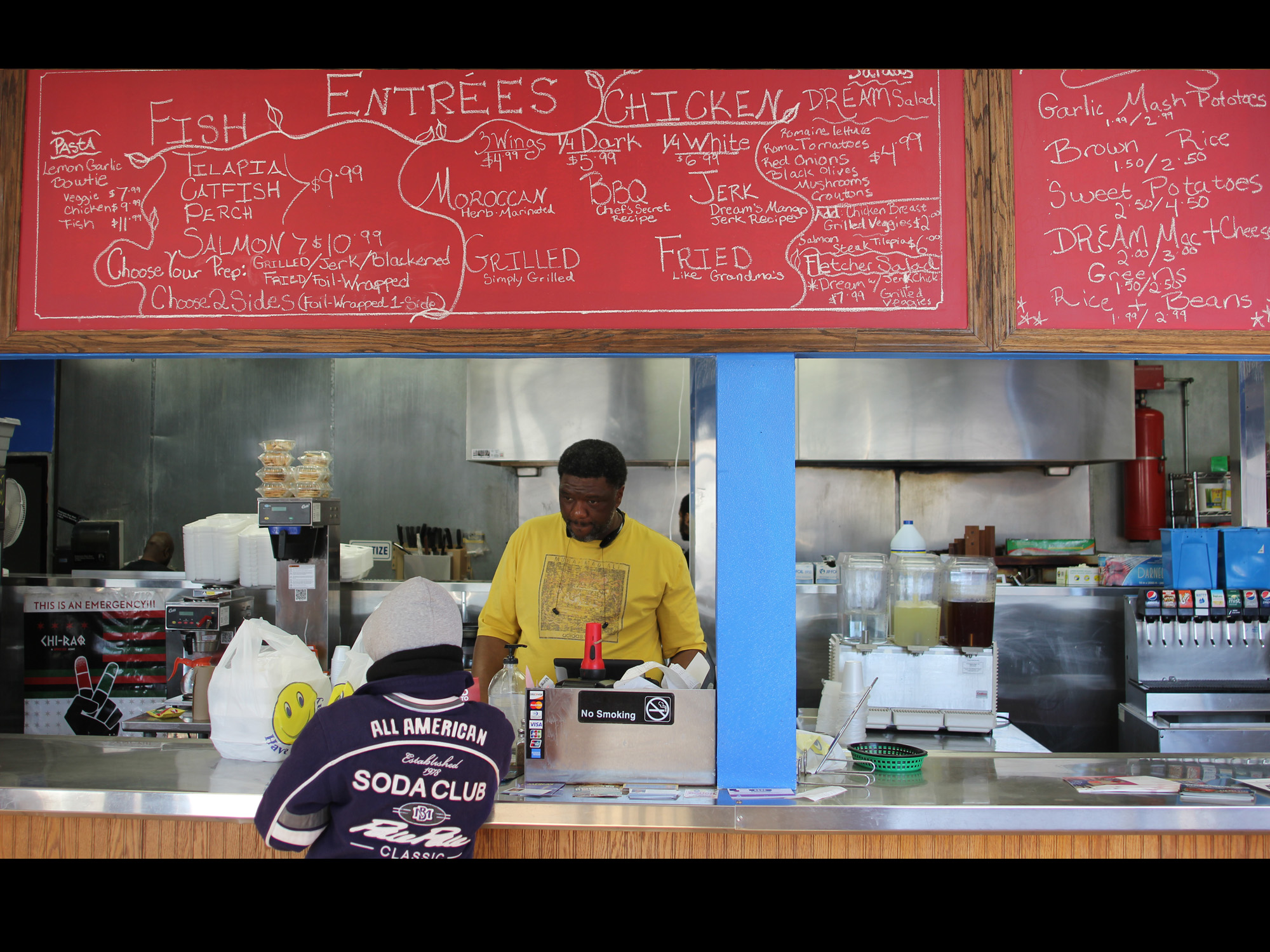IT WAS AN ENVIABLE POSITION. A YOUNG chef had just staged at Alinea for two weeks. He’d been asked to cook a protein, a vegetable, and a starch and he’d nailed it. Now he was being offered a job. Any chef in his position would be forgiven for entertaining a split second vision of cookbooks and a plain brick building with their name on it; any chef would be forgiven for letting the phrase Michelin Star roll around on his tongue before shaking hands and saying yes, yes of course, thank you. Thank you!
Chef John Nelson-Alden was thinking about dog food.
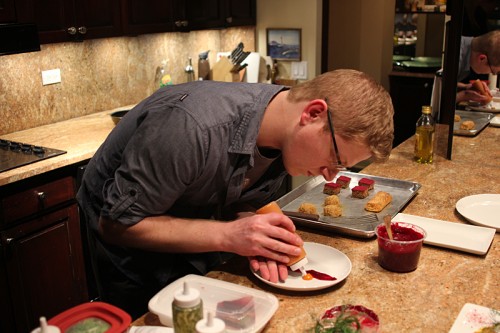
Chef John Nelson-Alden, plating.
He didn’t have a dog growing up. He’d wanted one badly but waited until he’d graduated Roosevelt University and rewarded himself with two poodles, Lui and Zoe. In short order, his parents inherited two dogs, then he and his wife rescued a schnoodle named JinJin, and before long Nelson-Alden found himself knocking out feed for eight dogs total. He spent his days as executive chef for the Gaslight bar on Halsted, obsessing over locally sourced organic food for people. Then he’d come home and obsess over the ingredients for pets.
There are a number of reasons why cooking for canines is not prominent in the culinary career trajectory for Chicago chefs:
- You didn’t go to school for that
- You’ll have to explain it to your mom
- Dogs don’t Yelp
Perhaps this last one is most salient for two reasons. First, running a successful food business requires a suicidal level of commitment on all fronts, but marketing is the front where one may find oneself most exhausted and vulnerable. Ask Bavette’s Bar and Boeuf about the power of Yelp. Ask Cantina 1910.
There are far more regulations when it comes to cooking for dogs than there are when cooking for humans.
Secondly, chefs need feedback. There’s a somewhat pornographic moment when a chef wants to peek into the dining room to watch someone’s eyes roll back in their head as they put their hand up to the table and mumble oh my God around a mouth full of the chef’s best work. There’s joy there. There’s purpose there. Before all the money and the cookbooks and the marketing and the goddam work of being a successful chef, there’s the undeniable desire to elicit mouthgasms and the reward of that person tweeting your glory.

Dog’s don’t do that. A dog will vomit cat turds then eat them again. Dogs lick their own butt. They’re not going to tell their friends about how you paired Veuve Clicquot with a Hog Island oyster and they saw God. Dogs don’t Yelp.
It is, however, only a matter of time. The social status of dogs is veering closer and closer to people. If you see a puppy at a table in Chicago, you don’t even Instagram it unless he’s wearing an adorable hat or playing a ukulele. The amount of paraphernalia dog owners consume is nearing hoarder levels: iPhone-based remote feeding rigs, interactive challenge-based dog feeders, ice-proof rubber booties. An app that measures tail wagging to food then auto tweets it is not only plausible, it’s probable. Hell, I’m going to patent it after writing this story.
Dog food, however, hardly keeps up with the progressive tech of their bowls. Most dog food is, as far as my limited research has shown, ground up horse feet and peas. All dog owners have that moment where we’ve peeled the lid off a can, glopped gloop into a bowl, then stared for a minute thinking a) why peas? and b) how is this fundamentally distinguishable from what he’s gonna leave in the yard in 20 minutes?
Even the very best dog food, a brand rated in the top tier by Dog Food Advisor, lists “… whole carrots, blueberries, sweet potatoes, pomegranate …” in the first lines of its ingredients. I don’t know many wild dogs, but I can tell you my border collie will eat a sock before he eats a pomegranate. That one’s in there just to impress Dad, not Bowser.
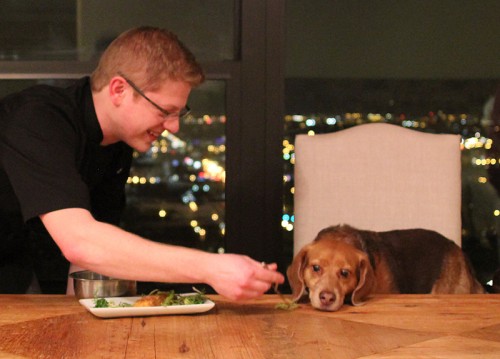
Recipe-testing his latest creation
IF HE TOOK THE JOB AT ALINEA, Nelson-Alden was looking at 70 hour weeks, minimum. Sure, he’d be cooking at a world class level, but he’d be fulfilling someone else’s vision. Maybe that’s part of dues. Maybe that’s foundation work chefs do. Nelson-Alden walked. He landed at GT Fish & Oyster under the tutelage of Giuseppe Tentori. He learned a lot about oysters. He fell in love with their criminally underrated eggplant dish. Then he fell in love with Karen Munoz, a Chicago attorney. They got married and like all newlyweds, spent their honeymoon figuring out how to run a dog food company.
“We were talking about our future, about the possibility of starting our own business,” Nelson-Alden told me. “The conversation bounced all over the place until at one point I said ‘all I know how to do is cook food and take care of dogs…’ I think the idea clicked in both of our heads at the same time.”
Turning it into a business was a little tougher. You can get a caterer’s license and a 1996 Step Van and start a croque monsieur truck on a whim. In a restaurant, a chef can whip up a plate of braised collard stems with smelt livers and Kraft cheese singles then turn around to anyone in the kitchen and say, dude, try this, and a dish is born.
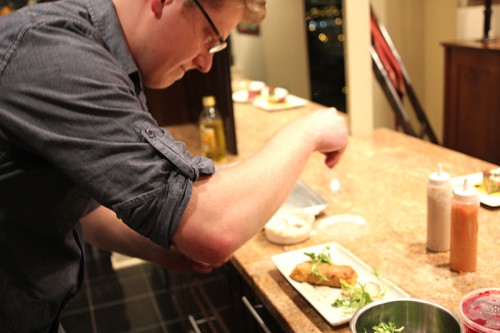
A salable product for a dog has to be approved by the Department of Agriculture who relies on the Association of American Feed Control Officials (AAFCO) for standards. Nelson-Alden used EPL Bioanalytical Services in Niantic, Illinois to test his product against those standards before submitting to the DOA for licensing.
“This was the longest part of the process,” he said. “It took a little over three months from the time we initially submitted everything, to the time we got our Feed Distribution and Manufacturing Facility License. One thing I did take away from this process: there are far more regulations when it comes to cooking for dogs than there are when cooking for humans.”
Most dog food is considered feed grade. That means it’s good enough for your dog but, dude, you wouldn’t put it into your mouth. There are no feed grade ingredients in the food made by Chestnut & Grace. It’s human grade. The beets in the frittata (yes, a frittata) are locally sourced; the eggs, the potatoes, the flour, they all come from Chicago stores. Nelson-Alden shops at Stanley’s and Jetro.
Nelson-Alden makes doggie meatloaf with the same ingredients you and I make people meatloaf. That’s the draw. Obviously, Chestnut & Grace doesn’t market to dogs (yet, see above). They market to dog owners. They market to the people who would cook for their dog if they had the time; people who are smart enough to Facebook-shame vegan cat food but still wonder if there’s a way to turn their Shih Tzu on to duck confit. Nelson-Alden spent two years with his nose buried in the Official Publication of the Association of American Feed Control Officials, a book so complicated it has official in the title twice. He should get an honorary degree in pet foodology. He knows what’s good for dogs and it’s in his product in spades.
But he also knows the only way to get his target market to purchase the food is if they want to eat it. That’s why the pictures on the Chestnut & Grace website are beautiful renditions of the ingredients. That’s why he took pictures of the food plated. Because it makes the people want to put it in their mouth. And they can. It’s human grade. You can eat this food.
I ate this food.
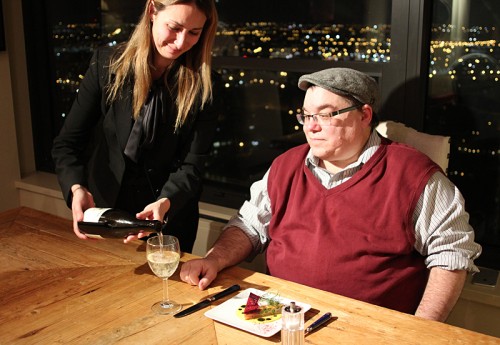
Chef John’s wife Karen pours my 2014 J Christopher Williamette Valley
I HAD TO. I DID IT FOR journalism. I did it because any schmuck with a halfway decent neck tattoo could claim to make chef inspired pet food that’s as good as human food, and get away with it because dogs will eat regurgitated road kill like it’s foie gras and their tail will wag into a blur. There’s no way to know if the food tastes good to people unless people taste it. Nelson-Alden is a decent enough guy and I trust him, but I didn’t do this for him, gentle reader, I did it for you.
I am, however, not a goddam savage. I reached out to Steve Morgan, somme at Formento’s and formerly of Alinea, for proper pairings.
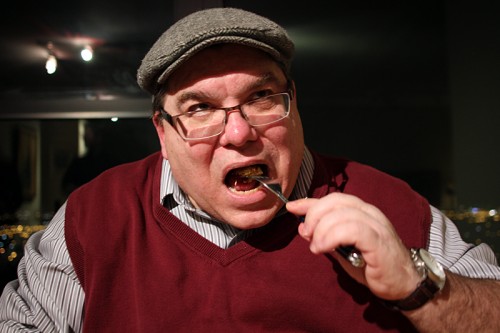

What follows is an unbiased review of the dog food of Chestnut & Grace, paired with world-class wines, as consumed by a fat snob.
In each case, I ate the exact product Chestnut & Grace sells to its customers. Once as packaged, then with seasoning. The only true difference was the plating. I ate the food during a photo shoot so Nelson-Alden carefully tweezed microgreens and dabbed basil puree like he was serving James Beard.
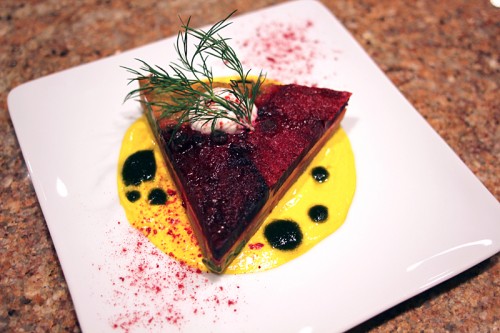
Beet & Potato Frittata: Roasted beets, russet potatoes, English peas, organic eggs
Beet & Potato Frittata: Roasted beets, Russet potatoes, English peas, organic eggs.
My first thought is I’m being punked. I expected the food to be palatable in the same way I might choke down a half a can of Ensure before flinging it across the room. I was not expecting it to be good. I was not expecting it, as scrawled in my notes, to be “fucking delicious.” I didn’t say that out loud. I didn’t want Nelson-Alden to get cocky right out of the gate. But it was really good, even without salt. The color was spectacular; the beets and potatoes were perfect. The peas made sense.
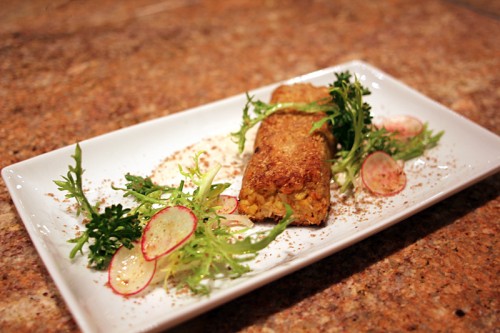
Alaskan Salmon Cake: wild caught Alaskan salmon, old-fashioned oats, Michigan apples, flaxseed oil
Alaskan Salmon Cake: Wild Caught Alaskan Salmon, old-fashioned oats, Michigan apples, flaxseed oil.
What the hell? This is delicious. This is one of those elevations of comfort food where you expect it to be pretty good then you take a bite and it’s so much more. It transports. Pairing it with a Bourgogne blanc perked it up and of course it needed some hot sauce, but it was fucking delicious and I was mad when they took it away.
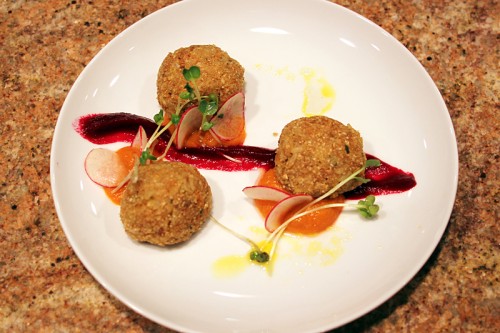
Chicken & Brown Rice Arancini: Amish chicken, parsnips, carrots, brown rice, old-fashioned oats, Italian parsley
Chicken & Brown Rice Arancini: Amish chicken, parsnips, carrots, brown rice, old-fashioned oats, Italian parsley.
I figured if any dish was going to fail, it would be the Arancini. Even Italians get this dish wrong, making it too hard or too mushy. Like a dog would care, even an Italian Greyhound wouldn’t know if these Amish chicken rice balls were authentic. But I did and they are and holy crap what’s going on here?
A word of advice: pairing it with an Oregonian pinot causes gastronomic distress, not because the food is bad, but because you’re in the middle of a photo shoot and your editor just takes the plate out from under you for a better shot like you’re a do– … Try that at Tru, you bastard. In my notes there are some words I can only print as asterisks here because they took the food away. I wanted to finish my plate.
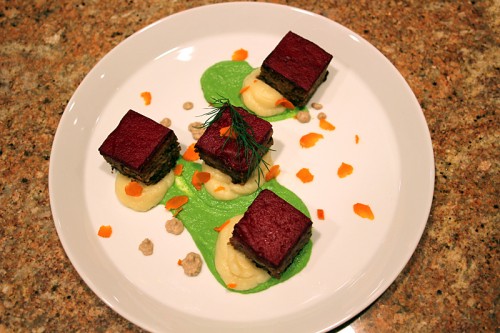
Beef & Potato Meatloaf: fresh ground chuck roast, russet potatoes, chicken livers, carrots, old-fashioned oats, Italian parsley, olive oil
Beef & Potato Meatloaf: Fresh ground chuck roast, russet potatoes, chicken livers, carrots, old-fashioned oats, Italian parsley, olive oil.
Son of a bitch. This is delicious. I mean, really delicious. Nelson-Alden worked harder on this plate than any other and it showed. Beautiful plating, just picturesque, which for a dog is meaningless but for me was heartwarming. Apparently, turmeric is very good for dogs so there was turmeric shaved like truffles onto the plate, and little emerald dabs of basil—and something else, little whorls of something taupe, something porridgesque, maybe a roux? I dipped my finger in it and felt a tremor of swoon.
“Oh my God, what is this?”
“Gravy.”
Gravy. Chestnut & Grace sells it to mix into your dog’s dry food. Kind of a stepper to a full-on Chestnut & Grace diet. Gravy. It is perhaps the most evocative food on the plate. It’s comfort food of the highest order. It’s what you put onto mashed potatoes. Gravy is the bridge between the wagging tail of a Shih Tzu and the eyes rolling back in the head of their owner. Gravy is evil. Gravy genius. Gravy is the song of my people.

I like it!
This was the last dish during the photo shoot so the photographer and his dog and the chef and like three other people were done with me. They swept a plate of Arancini off the table for the dog who wagged his tail and buried his snout in the food and did dog stuff which everyone thought was adorbs so they ignored me and I finished my meatloaf.
Think about that.
Look here’s the deal: I eat well. I’ve plowed through the best restaurants in Chicago; I’ve eaten at GT Fish & Oyster (probably while Nelson-Alden was shucking oysters in the back) and Sepia and Steak & Egger so I have the palate of a Goddam hideous reprobate snob bitch and I finished my fucking plate of dog food.
It’s that good.
I know dogs don’t Yelp, but if they could, Chestnut & Grace would be at the top of their list.
Steve Morgan’s Wine Pairings For Dog Food
 Steve Morgan
Steve Morgan Woody Morgan
Steve Morgan is the sommelier at Formento’s in the West Loop, but before that he spent a couple of years as the sommelier at three-star Alinea, and he has a boxer mix named Woody, so he seemed an excellent choice to turn to for advice on pairing John Nelson-Alden’s food with food-friendly, dog-friendly wines. His picks:
Beet & Potato Frittata: Roasted beets, Russet potatoes, English peas, organic eggs
Steve suggests: “Wow, this sounds delicious for me! Roasted beets and english peas scream for some new world sauvignon blanc. The fruity and earth notes of the components will match lovely against the ripe fruit and mildly vegetal notes of sauvignon blanc. We are currently pouring the J Christopher Sauvignon Blanc from Willamette Valley in Oregon which is made in a fresh loire style. Other great sauvignon blanc that would match come from Stolpman and Lieu Dit in Santa Barbara and Long Meadow Ranch and Spottswoode in Napa.”
Alaskan Salmon Cake: Wild Caught Alaskan Salmon, old-fashioned oats, Michigan apples, flaxseed oil
Steve suggests: “Apples and salmon and oats bring to mind how much I love certain white burgundies that not only show off the apple, pear and citrus notes but convey a certain level of ‘crunchiness’ on the palate. Admittedly the crunchiness only grows with age so seeking out a well kept aged white burgundy may be an expensive proposition but also a worthy pairing. Leroy Bourgogne Blanc is a good option without going to crazy on price. If you want to try something interesting a little caricante from Mount Etna would be a quirky yet exciting pairing.”
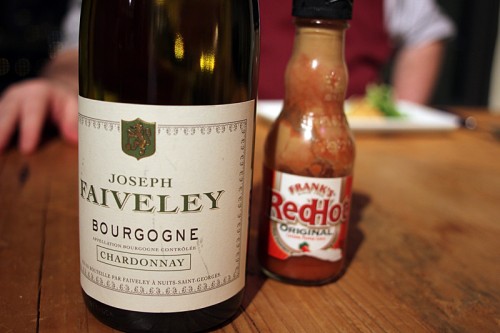
Chicken & Brown Rice Arancini: Amish chicken, parsnips, carrots, brown rice, old-fashioned oats, Italian parsley
Steve suggests: “Pinot noir or gamay are a perfect pair with the sweet roast vegetable and succulent amish chicken. Fresh ripe fruit in the front of the palate, but a little herbal notes will play beautifully with the parsley and grains. I would go new world on this one as well, but nothing overripe. A great Oregon pinot from Antica Terra, Bethel Heights, Brooks or Eyrie would do the trick.”
Beef & Potato Meatloaf: Fresh ground chuck roast, russet potatoes, chicken livers, carrots, old-fashioned oats, Italian parsley, olive oil.
Steve suggests: “Chicken livers were everywhere in central Italy when I travelled through and make me want Sangiovese. Sangiovese can have a beautiful black cherry fruit, elegant but present tannins, and a little floral and anise note as well. It is not a super full-bodied wine but it is texturally quite engaging and cuts through the richness of a meatloaf well. Isole e Olena makes an elegant and structured example if you are looking for something that plays on the lighter side, where a wine like the La Spinetta Casanova Chianti Riserva would play to the heartier palate with similar success.”
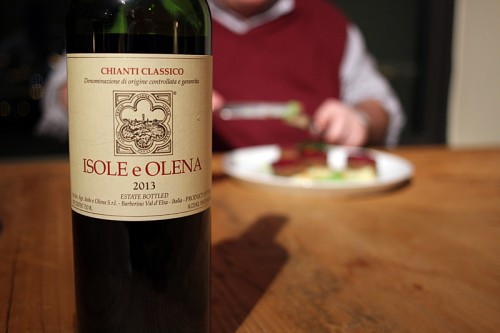
Bull Garlington is the proprietor of Eating Vincent Price, an underground dinner series in Chicago devoted to the late actor’s 1960s cookbook, and is co-author of The Beat Cop’s Guide to Chicago Eats. An award winning humorist and popular speaker, his most recent book, Death by Children, was a 2013 book of the year finalist for the Midwest Publishers Association, and 2013 Humor Book of the Year by the prestigious industry standard, ForeWard Reviews. Garlington’s features have appeared in newspapers and magazines across the nation since 1989; he won the Parenting Media Association’s Gold Award for best humor column in 2013, and the Silver Award for best humor article in 2012, and the booze in 2010.
Learn more at Chestnutandgracedogfood.com
Special thanks to Nicole Aylward, Steve Morgan, Karen Munoz, Pete Dougherty, Liam Gebert and Buster.
Latest
Join the Discussion
After you comment, click Post. If you're not already logged in you will be asked to log in or register with Disqus.





